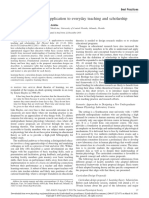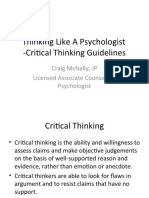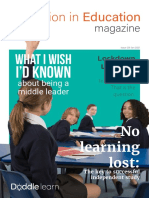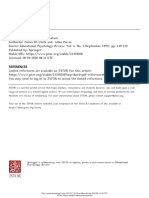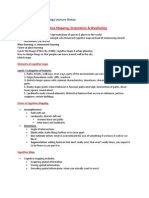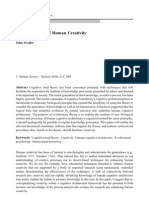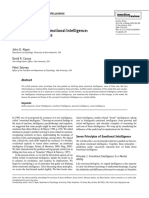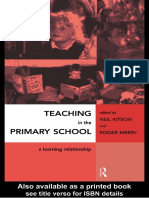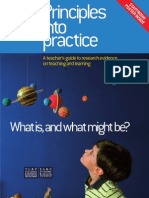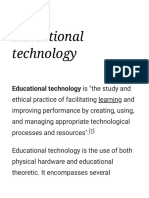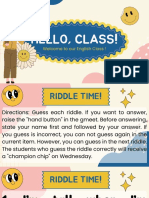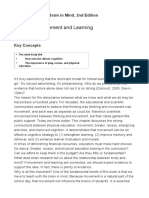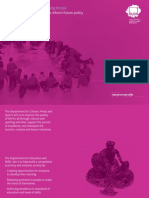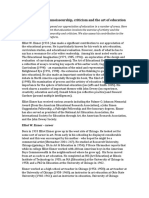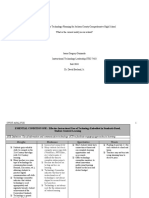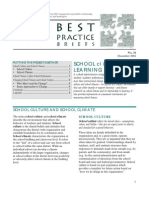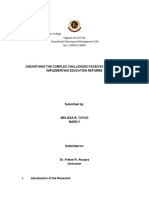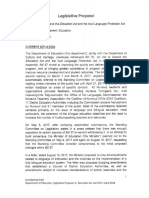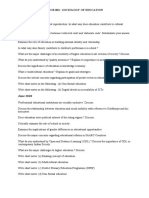Rethinking Learning in The Digital Age
Rethinking Learning in The Digital Age
Uploaded by
Rui TeixeiraCopyright:
Available Formats
Rethinking Learning in The Digital Age
Rethinking Learning in The Digital Age
Uploaded by
Rui TeixeiraOriginal Title
Copyright
Available Formats
Share this document
Did you find this document useful?
Is this content inappropriate?
Copyright:
Available Formats
Rethinking Learning in The Digital Age
Rethinking Learning in The Digital Age
Uploaded by
Rui TeixeiraCopyright:
Available Formats
CHAPTER 3
Rethinking Learning in the Digital Age
Mitchel Resnick
The Media Laboratory Massachusetts Institute of Technology
irst, the good news: in the years ahead, the declining cost of computation will make digital technologies accessible to nearly everyone in all parts of the world, from inner-city neighborhoods in the United States to rural
villages in developing nations. These new technologies have the potential to fundamentally transform how and what people learn throughout their lives. Just as advances in biotechnologies made possible the green revolution in agriculture, new digital technologies make possible a learning revolution in education. Now, the bad news: while new digital technologies make a learning revolution possible, they certainly do not guarantee it. Early results are not encouraging. In most places where new technologies are being used in education today, the technologies are used simply to reinforce outmoded approaches to learning. Even as scientific and technological advances are transforming agriculture, medicine, and industry, ideas about and approaches to teaching and learning remain largely unchanged. To take full advantage of new technologies, we need to fundamentally rethink our approaches to learning and education and our ideas of how new technologies can support them.
Beyond Information
When people think about education and learning, they often think about information. They ask questions like: What information is most important for people to know? What are the best ways to transmit that information from one person (a teacher) to another (a learner)? What are the best ways to represent and display information so that it is both understandable and learnable? Its not surprising that people see a natural connection between computers and education. Computers enable people to transmit, access, represent, and manipulate information in many new ways. Because education is associated with information and computers are associated with information, the two seem to make a perfect marriage. This focus on information, however, is limiting and distorting, both for the field of education and for computers. If we want to take full advantage of new computational technologies, and if we want to help people become better thinkers and learners, we need to move beyond these information-centric views of computing and learning.
32
CHAPTER 3 Rethinking Learning in the Digital Age
Over the past fifty years, psychologists and educational researchers, building on the pioneering work of Jean Piaget, have come to understand that learning is not a simple matter of information transmission. Teachers cannot simply pour information into the heads of learners; rather, learning is an active process in which people construct new understandings of the world around them through active exploration, experimentation, discussion, and reflection. In short: people dont get ideas; they make them. As for computers, they are more than simply information machines, despite the common use of the phrase information technology or IT. Of course, computers are wonderful for transmitting and accessing information, but they are, more broadly, a new medium through which people can create and express. If we use computers simply to deliver information to students, we are missing the revolutionary potential of the new technology for transforming learning and education. Consider the following three things: computers, television, finger paint. Which of the three doesnt belong? For most people, the answer seems obvious: finger paint doesnt fit. After all, computers and televisions were both invented in the twentieth century, both involve electronic technology, and both can deliver information to large numbers of people. None of that is true for finger paint. But until we start to think of computers more like finger paint and less like television, computers will not live up to their full potential. Like finger paint (and unlike television), computers can be used for designing and creating things. In addition to accessing Web pages, people can create their own Web pages. In addition to downloading MP3 music files, people can compose their own music. In addition to playing SimCity, people can create their own simulated worlds. It is design activities such as these that offer the greatest new learning opportunities with computers. Research has shown that many of our best learning experiences come when we are engaged in designing and creating things, especially things that are meaningful either to us or others around us (e.g., Papert 1993). When children create pictures with finger paint, for example, they learn how colors mix together. When they build houses and castles with building blocks, they learn about structures and stability. When they make bracelets with colored beads, they learn about symmetries and patterns. Like finger paint, blocks, and beads, computers can also be used as a material for making thingsand not just by children, but by everyone. Indeed, the computer is the most extraordinary construction material ever invented, enabling people to create anything from music videos to scientific simulations to robotic creatures. Computers can be seen as a universal construction material, greatly expanding what people can create and what they can learn in the process (Resnick 1998).
Digital Fluency
Unfortunately, most people dont use computers that way today. When people are introduced to computers today, they are typically taught how to look up information on the Web, how to use a word processor, how to send e-mail. But they dont become fluent with the technology. What does it mean to be digitally fluent? Consider the analogy with learning a foreign language. If someone learned a few phrases so that they could read menus in restaurants and ask for directions on the street, would you consider them fluent in the language? Certainly not. That type of phrase-book knowledge is equivalent to the way most people use computers today. Is such knowledge useful? Yes. But it is not fluency. To be truly fluent in a foreign language, you must be able to articulate a complex idea or tell an engaging story; in other words, you must be able to make things with language. Analogously, being digitally fluent involves not only knowing how to use technological tools, but also knowing how to construct things of significance with those tools (Papert and Resnick 1995). Fluency with language not only has great utilitarian value in everyday life but also has a catalytic effect on learning. When you learn to read and write, you are in a better position to learn many other things. So, too, with digital fluency. In the years ahead, digital fluency will become a prerequisite for obtaining jobs, participating meaningfully in society, and learning throughout a lifetime. Today, discussions about the digital divide typically focus on differences in access to computers. That will change. As the costs of computing decline, people everywhere will gain better access to digital technologies. But there is a real risk that only a small handful will be able to use the technologies fluently. In short, the access gap will shrink, but a serious fluency gap could remain.
33
CHAPTER 3 Rethinking Learning in the Digital Age
Computer Clubhouses
To provide more young people with the opportunity to become digitally fluent, the Massachusetts Institute of Technology (MIT) Media Lab and the Boston Museum of Science have established a network of learning centers in economically disadvantaged communities. At these centers, called Computer Clubhouses, young people become designers and creators with new digital technologies. Clubhouse members use leading-edge software to create their own artwork, animations, simulations, multimedia presentations, musical compositions, websites, and robotic constructions (Resnick et al. 1998). The first Computer Clubhouse opened in 1993 in Boston, serving youth between the ages of ten and eighteen. Based on
the success of the initial Clubhouse, a dozen more communities opened Computer Clubhouses over the next six years. Then, in 2000, Intel announced that it would provide support to open an additional hundred Computer Clubhouses around the world over the ensuing five years. There are now Clubhouses in India, Ireland, Israel, Colombia, Germany, the Philippines, and the United States, with new Clubhouses planned for 2002 in China, Costa Rica, Mexico, South Africa, and Taiwan. Computer Clubhouses are very different from most telecenters and community technology centers, which typically fall in one of two categories. Some technology centers merely provide access. People can do whatever they want: play games, surf the Web, use online chat rooms. Other centers offer structured courses teaching basic computer skills (such as keyboarding) and basic applications (such as word processing and spreadsheets). Computer Clubhouses offer a third path, with different goals and a different approach. The aim is not simply to teach basic skills, but to help young people learn to express themselves and gain confidence in themselves as learners. If they are interested in video games, they dont come to the Clubhouse to play games; they come to create their own games. They dont download videos from the Web; they create their own videos. In the process, youth learn the heuristics of being a good designer: how to conceptualize a project, how to make use of the materials available, how to persist and find alternatives when things go wrong, how to collaborate with others, and how to view a project through the eyes of others. In short, they learn how to manage a complex project from start to finish. The Computer Clubhouse approach strikes a balance between structure and freedom in the learning process. As Clubhouse youth work on projects based on their own interests, they receive a great deal of support from other members of the Clubhouse community (e.g., staff members, volunteer mentors, and other Clubhouse youth). There is a large collection of sample projects on the walls, shelves, and hard drives of the Clubhouses; these provide Clubhouse youth with a sense of the possible, and multiple entry points through which they can start. The goal is to provide enough freedom to enable Clubhouse youth to follow their fantasies, but also enough support to help them turn those fantasies into realities. There is no doubt that the lives of many Computer Clubhouse members have been transformed by their time at the Clubhouses. Consider Mike Lee, who spent time at the original Computer Clubhouse in Boston. Mike first came to the Clubhouse after he had dropped out of high school. His true passion was drawing. He filled up notebook after notebook with sketches of cartoon characters. At the Clubhouse, Mike Lee developed a new method for his artwork. First, he would draw black-and-white sketches by hand. Then, he would scan the
Figure 1
sketches into the computer and use the computer to color them in. His work often involved comic-book images of himself and his friends (Figure 1).
Over time, Mike learned to use more advanced computer techniques in his artwork (Figure 2). Everyone in the Clubhouse was impressed with Mikes creations, and other youth began to come to him for advice. Some members explicitly mimicked Mikes artistic style. Before long, a collection of Mike Lee style artwork filled the bulletin boards of the Clubhouse (Figure 3). Its kind of flattering, says Mike. For the first time in Mikes life, other people Figure 2 were looking up to him. He began to feel a new sense of responsibility. He decided to stop using guns in his artwork, feeling that it was a bad influence on the younger Clubhouse members. My own personal artwork is more hard core, about street violence. I had a close friend who was shot and died, Mike explains. But I dont want to bring that here. I have an extra responsibility. Kids dont understand about guns; they think its cool. They see a fight, its natural they want to go see it. They dont understand. Figure 3 Theyre just kids. Mike Lee began working with others at the Clubhouse on collaborative projects. Together, they created an online art gallery. Once a week, they met with a local artist who agreed to be a mentor for the project. After a year, their online art show was accepted as an exhibition at Siggraph, the worlds premiere computergraphics conference.
34
CHAPTER 3 Rethinking Learning in the Digital Age
As Mike worked with others at the Clubhouse, he began to experiment with new artistic techniques. He added more computer effects, and he began working on digital collages combining photographs and graphics, while still maintaining his distinctive style (Figure 4). Over time, Mike explored how he might use his artwork as a form of social commentary and political expression (Figure 5). As he worked at the Clubhouse, Mike Lee clearly learned a lot about computers and about graphic design. But he also began to develop his own ideas about teaching and learning. At the Clubhouse, I was free to do what I wanted, learn what I wanted, says Mike. Whatever I did was just for me. If I had taken computer courses [in school], there would have been all those assignments. Here I could be totally creative. Mike remembersand appreciateshow the staff members treated him when he first started at the Clubhouse. They asked him to design the sign for the entrance to the Clubhouse, and looked to him as a resource. They never thought of him as a highschool dropout but as an artist. Mikes artwork still has the same distinctive style, but he has become more fluent in expressing himself in computer-based media. Describing his current work, Mike talks about dither nightmares and anti-aliasing problemsideas that would have been alien to him a few years ago. He says his artwork is ten times better than last year.
Figure 4
Figure 5
programmable bricks to control motors, receive information from sensors, and even communicate with one another. The LEGO Company now sells a commercial version of these programmable bricks, under the name LEGO MindStorms. Children have used our programmable bricks to build a variety of creative constructions, including an odometer for rollerblades (using a magnetic sensor to count wheel rotations); a diary-security system (using a touch sensor to detect if anyone tried to open the diary); and an automated hamster cage (using a light sensor to monitor the hamsters movements). One 11-year-old girl, named Jenny, was very interested in birds, and she decided to use programmable bricks to build a new type of bird feeder. She started by making a wooden lever that served as a perch for the birds. When a bird landed, it would trigger a touch sensor, sending a signal to a programmable brick, which turned on a LEGO mechanism, which pushed down the shutter of a camera, taking a picture of the bird. The design-oriented nature of the project was clearly very important for Jenny. As she described it: The fun part is knowing that you made it; my machine can take pictures of birds. At the same time, the project served as a rich context for engaging in scientific inquiry and learning science-related concepts. Jenny developed a deeper understanding of some concepts (such as mechanical advantage) that she had previously studied in school but had never really appreciated. She also began to work with some engineering concepts (related to feedback and control) that are traditionally taught only at the university level (Resnick et al. 2000). Programmable bricks provided Jenny with design leverage, enabling her to create things that would have been difficult for her to create in the past. At the same time, the bricks provided Jenny with conceptual leverage, enabling her to learn concepts that would have been difficult for her to learn in the past.
Rethinking Technologies
In addition to rethinking our approaches to learning and education, we also need to rethink the technologies that we provide to young people. Most of todays computers were designed primarily for use by adults in the workplace. We need to develop a new generation of computer technologies worthy of the next generation of children. Its not enough just to make computers faster; we need to develop new types of computers. Todays youth are ready and eager to do more with computers. We need to provide the hardware and software that will enable them to do so. These new technologies might look very different from traditional computers. For example, my research group has developed a family of programmable bricks: tiny computers embedded inside childrens building blocks (Martin et al. 2000; Resnick et al. 1996). With these bricks, children can build computational power directly into their physical-world constructions, using the
35
CHAPTER 3 Rethinking Learning in the Digital Age
Reforming Educational Reform
Increasingly, nations are recognizing that improving education is the best way to increase wealth, enhance health, and maintain peace. But there is little consensus on how to achieve an educated population, or even on what it means to have an educated population. Can progress towards an educated population be measured by counting the number of people in school? By the number of years they spend in school? By assessing their grades on standardized tests? Every country in the world, it seems, has a plan for educational reform. But, in most cases, reform initiatives are superficial and incremental, and do not get at the heart of the problem. These initiatives often introduce new forms of testing and assessment, but leave in place (or make only small incremental changes to) existing curricula and existing teaching strategies. We need to reform educational reform. Rethink how people learn. We need to fundamentally reorganize school classrooms. Instead of a centralized-control model (with a teacher delivering information to a roomful of students), we should take a more entrepreneurial approach to learning. Students can become more active and independent learners, with the teacher serving as consultant, not chief executive. Instead of dividing up the curriculum into separate disciplines (math, science, social studies, language), we should focus on themes and projects that cut across the disciplines, taking advantage of the rich connections among different domains of knowledge. Instead of dividing students according to age, we should encourage students of all ages to work together on projects, enabling them to learn from one another (and to learn by teaching one another). Instead of dividing the school day into hour-long slices, we should let students work on projects for extended periods of time, enabling them to follow through more deeply and meaningfully on the ideas that arise in the course of their work. Rethink what people learn. Much of what children learn in schools today was designed for the era of paper-and-pencil. We need to update curricula for the digital age. One reason is obvious: Schools must prepare students with the new skills and ideas that are needed for living and working in a digital society. There is a second, subtler reason: new technologies are changing not only what students should learn, but also what they can learn. There are many ideas and topics that have always been important but were left out of traditional school curricula because they were too difficult to teach and learn with only paper, pencil, books, and blackboard. Some of these ideas are now accessible through creative use of new digital technologies. For example, children can now use computer simulations to explore the workings of systems in the world (everything from ecosystems to economic systems to immune systems) in ways that were previously not possible. Some ideas
that were previously introduced only at the university level can and should be learned much earlier. Finally, and perhaps most importantly, we need to transform curricula so that they focus less on things to know and more on strategies for learning the things you dont know. As new technologies continue to quicken the pace of change in all parts of our lives, learning to become a better learner is far more important than learning to multiply fractions or memorizing the capitals of the world. Rethink where and when people learn. Most education-reform initiatives appear to assume that learning takes place only between the ages of 6 and 18, between 8:00 A.M. and 3:00 P.M.that is, when children are in schools. But schools are just part of a broader learning ecosystem. In the digital age, learning can and must become a daylong and lifelong experience. National education initiatives should aim to improve learning opportunities not only in schools, but also in homes, community centers, museums, and workplaces. In Denmark, for example, the Ministry of Education joined with the Ministry of Business and Industry to create Learning Lab Denmark, a new research lab that studies learning in all settings, in all stages of life. In the years ahead, the Internet will open up new learning opportunities, enabling new types of knowledgebuilding communities in which children (and adults) around the globe collaborate on projects and learn from one another.
Towards the Creative Society
In the 1980s, there was much talk about the transition from the Industrial Society to the Information Society. No longer would natural resources and manufacturing be the driving forces in our economies and societies. Information was the new king. In the 1990s, people began to talk about the Knowledge Society. They began to realize that information itself would not bring about important change. Rather, the key was how people transformed information into knowledge and managed that knowledge. The shift in focus from information to knowledge is an improvement. But I prefer a different conception: the Creative Society. As I see it, success in the future will be based not on how much we know, but on our ability to think and act creatively. The proliferation of digital technologies has accentuated the need for creative thinking in all aspects of our lives, and has also provided tools that can help us improve and reinvent ourselves. Throughout the world, computing and communications technologies are sparking a new entrepreneurial spirit, the creation of innovative products and services, and increased productivity. The importance of a well-educated, creative citizenry is greater than ever before.
36
CHAPTER 3 Rethinking Learning in the Digital Age
Children should play a central role in this transition to the Creative Society. Childhood is one of the most creative periods of our lives. We must make sure that childrens creativity is nourished and developed, and we must help children learn how to extend and refine their creative abilities, so that the creativity of childhood persists and grows throughout life. To achieve these goals will require new approaches to education and learning, and new types of technologies to support those new approaches. The ultimate goal is a society of creative individuals who are constantly inventing new possibilities for themselves and their communities.
Acknowledgements
Many people have contributed to the projects and ideas described in this paper. I am particularly grateful to Robbie Berg, Rick Borovoy, Gail Breslow, Stina Cooke, John Galinato, Fred Martin, Bakhtiar Mikhak, Seymour Papert, Natalie Rusk, Brian Silverman, and Claudia Urrea. The projects described in this paper have received generous support from many sponsors of the MIT Media Lab, most notably the LEGO Company, Intel Corporation, and the National Science Foundation. The ideas about the Creative Society were developed through my participation in the Next Generation Forum.
References
Martin, F., B. Mikhak, and B. Silverman. MetaCricket: A Designers Kit for Making Computational Devices. IBM Systems Journal 39, 3 & 4 (2000): 795815. Papert, S. The Childrens Machine: Rethinking School in the Age of the Computer. New York: Basic Books, 1993. Papert, S., and M. Resnick. Technological Fluency and the Representation of Knowledge. Proposal to the National Science Foundation. MIT Media Laboratory (1995). Resnick, M., F. Martin, R. Sargent, and B. Silverman. Programmable Bricks: Toys to Think With. IBM Systems Journal 35 (1996):443452. Resnick, M. Technologies for Lifelong Kindergarten. Educational Technology Research and Development 46, 4 (1998). Resnick, M., N. Rusk, and S. Cooke. The Computer Clubhouse: Technological Fluency in the Inner City. In High Technology and LowIncome Communities, edited by D. Schon, B. Sanyal, and W. Mitchell. Cambridge: MIT Press, 1998: 266286. Resnick, M., R. Berg, and M. Eisenberg. Beyond Black Boxes: Bringing Transparency and Aesthetics Back to Scientific Investigation. Journal of the Learning Sciences 9 (2000): 730.
37
CHAPTER 3 Rethinking Learning in the Digital Age
You might also like
- Ainsworth Rigourous Curric Diagram PDFDocument1 pageAinsworth Rigourous Curric Diagram PDFChrisNo ratings yet
- American Reform Movements Between 1820 and 1860 Reflected Both Optimistic and Pessimistic Views of Human Nature and SocietyDocument1 pageAmerican Reform Movements Between 1820 and 1860 Reflected Both Optimistic and Pessimistic Views of Human Nature and Societybobbob4750% (2)
- HowlearninghappensDocument52 pagesHowlearninghappensapi-344655606No ratings yet
- Cognitive Psychology: History: Edward E Smith, University of Michigan, Ann Arbor, MI, USADocument7 pagesCognitive Psychology: History: Edward E Smith, University of Michigan, Ann Arbor, MI, USARanjan Kumar Singh100% (1)
- MOA Failing GradesDocument4 pagesMOA Failing Gradesjecelyn mae Baluro100% (1)
- Creativity: Creativity Is A Phenomenon Whereby Something Somehow New and Somehow Valuable Is Formed. TheDocument48 pagesCreativity: Creativity Is A Phenomenon Whereby Something Somehow New and Somehow Valuable Is Formed. Theguitar_theoryNo ratings yet
- Creativity: Process and PersonalityDocument142 pagesCreativity: Process and Personalityleif_eriksson_89No ratings yet
- Creativity 5Document12 pagesCreativity 5api-26570979No ratings yet
- Experiential Learning: Experience As The Source of Learning and Development - KolbDocument23 pagesExperiential Learning: Experience As The Source of Learning and Development - KolbJonathan HigginsNo ratings yet
- Learning Theories 101: Application To Everyday Teaching and ScholarshipDocument9 pagesLearning Theories 101: Application To Everyday Teaching and ScholarshipmilitapiaNo ratings yet
- Models PacketDocument24 pagesModels PacketMansi NarangNo ratings yet
- Activity Theory As A Lens For Characterizing The Participatory UnitDocument16 pagesActivity Theory As A Lens For Characterizing The Participatory UnitShaimaa Abdel MagiedNo ratings yet
- Neuroeducation Brain Science Meets Educa PDFDocument63 pagesNeuroeducation Brain Science Meets Educa PDFfede37No ratings yet
- Wk. 2 - Thinking Like A Psychologist Critical ThinkingDocument18 pagesWk. 2 - Thinking Like A Psychologist Critical ThinkingShayyy JacksonNo ratings yet
- Pyc 2601 Study GuideDocument256 pagesPyc 2601 Study GuideJoanneNo ratings yet
- Innovation in Education 001Document11 pagesInnovation in Education 001Nicole LeeNo ratings yet
- Zimmerman Bandura y MartinezDocument14 pagesZimmerman Bandura y MartinezLizbeth FloresNo ratings yet
- 10 4324@9780203839010 ch26Document19 pages10 4324@9780203839010 ch26Jesus Jimenez100% (1)
- Exemplary Classroom Questioning: Practices to Promote Thinking and LearningFrom EverandExemplary Classroom Questioning: Practices to Promote Thinking and LearningRating: 5 out of 5 stars5/5 (1)
- Towards Third Generation Learning and Teaching: Contours of the New LearningFrom EverandTowards Third Generation Learning and Teaching: Contours of the New LearningNo ratings yet
- Dual Coding Theory in Education - Clark & Paivio 1991Document63 pagesDual Coding Theory in Education - Clark & Paivio 1991Rebecca GallagherNo ratings yet
- Environmental Psychology Lecture Notes: Cognitive Maps & Way FindingDocument3 pagesEnvironmental Psychology Lecture Notes: Cognitive Maps & Way FindingGeneric_PersonaNo ratings yet
- COGNITIVE PSY Unit 1-2 Notes ShivaniDocument56 pagesCOGNITIVE PSY Unit 1-2 Notes ShivaniShivani MaratheNo ratings yet
- How The Internet Makes Us StupidDocument5 pagesHow The Internet Makes Us StupidimtellinyaNo ratings yet
- The Grid As An Artistic Tool - Adhd Lesson PlanDocument5 pagesThe Grid As An Artistic Tool - Adhd Lesson Planapi-246390692No ratings yet
- Science Education in Theory and PracticeDocument507 pagesScience Education in Theory and PracticeElsaSiuNo ratings yet
- Bandura SocialLearningTheoryDocument106 pagesBandura SocialLearningTheoryBenToNo ratings yet
- Cognitive Bases of Human Creativity: Educ Psychol Rev DOI 10.1007/s10648-008-9091-6Document9 pagesCognitive Bases of Human Creativity: Educ Psychol Rev DOI 10.1007/s10648-008-9091-6Ioana RidelNo ratings yet
- Teaching For Thinking by SternDocument140 pagesTeaching For Thinking by SternstefansalNo ratings yet
- Barsalou - 1999 - Perceptual Symbol SystemsDocument84 pagesBarsalou - 1999 - Perceptual Symbol SystemsAlexandru RoșuNo ratings yet
- ComparisonDocument23 pagesComparisonHanny HusrunNo ratings yet
- 2018 Book ShapingTheUniversityOfTheFuturDocument592 pages2018 Book ShapingTheUniversityOfTheFuturMohamed Mo Galal Hassan-Ghariba100% (1)
- NSF Chapter 1Document17 pagesNSF Chapter 1bisgovukNo ratings yet
- Marilyn (2021) Outdoor Learning and Play (Book)Document212 pagesMarilyn (2021) Outdoor Learning and Play (Book)陳水恩100% (1)
- Differentiation With UdlDocument19 pagesDifferentiation With Udlapi-235755026No ratings yet
- Mindstorms Children Computers and Powerful IdeasDocument242 pagesMindstorms Children Computers and Powerful IdeasLemniscata ACNo ratings yet
- Mayer, Caruso, & Salovey. The Ability Model of EI. Principles and UpdatesDocument11 pagesMayer, Caruso, & Salovey. The Ability Model of EI. Principles and UpdatesMarta Cañero PérezNo ratings yet
- Computers As Persuasive Social ActorsDocument32 pagesComputers As Persuasive Social ActorsSummer TeohNo ratings yet
- The Quantitative Analysis of Social RepresentationsDocument83 pagesThe Quantitative Analysis of Social Representationsrogeliodelprado1282100% (1)
- NCFDocument3 pagesNCFBhumikaNo ratings yet
- A Learning RelationshipDocument204 pagesA Learning RelationshipAnna K. RiveraNo ratings yet
- Principles in Practice Low Res PDFDocument28 pagesPrinciples in Practice Low Res PDFElle ShinNo ratings yet
- Edward de Bono - SixDocument10 pagesEdward de Bono - SixpedroNo ratings yet
- Educational Technology - Wikipedia PDFDocument201 pagesEducational Technology - Wikipedia PDFdivyashreeNo ratings yet
- Self Determination Theory - An Introduction and OverviewDocument25 pagesSelf Determination Theory - An Introduction and OverviewInês100% (1)
- Personalised Learning - Dannikea HoltomDocument9 pagesPersonalised Learning - Dannikea Holtomapi-415360536No ratings yet
- Universal Design For Learning in PeDocument17 pagesUniversal Design For Learning in Peapi-730469526No ratings yet
- Lucky To Be A Teacher: Life-Changing Affirmations for Positive ClassroomsFrom EverandLucky To Be A Teacher: Life-Changing Affirmations for Positive ClassroomsRating: 4 out of 5 stars4/5 (1)
- Assure ModelDocument2 pagesAssure Modelapi-317151826No ratings yet
- Additional Resources and References Books, Articles, Websites and On-Line Videos. ReferencesDocument8 pagesAdditional Resources and References Books, Articles, Websites and On-Line Videos. ReferencesLina SantosNo ratings yet
- WK 2 Four Types of Thinking StyleDocument5 pagesWK 2 Four Types of Thinking StyleBrooke TillmanNo ratings yet
- Effectiveness of Classroom Management in Basic Schools in Ghana Views From Teachers in KEEA Municipality SchoolsDocument8 pagesEffectiveness of Classroom Management in Basic Schools in Ghana Views From Teachers in KEEA Municipality SchoolsInternational Journal of Innovative Science and Research TechnologyNo ratings yet
- Gammification For Human Factor IntegrationDocument363 pagesGammification For Human Factor IntegrationSlaymen BonillNo ratings yet
- An Evidence-Based Approach To Teaching and LearningDocument5 pagesAn Evidence-Based Approach To Teaching and LearningFrancis Andru Reyes DimaandalNo ratings yet
- How Should Critical Thinking Be Conceptualized?Document10 pagesHow Should Critical Thinking Be Conceptualized?Azher BeboNo ratings yet
- Thought Provoking Questions PDFDocument39 pagesThought Provoking Questions PDFJohn Christopher BayudanNo ratings yet
- Innovator's Guidebook: Intel Youth Enterprise ProgramDocument15 pagesInnovator's Guidebook: Intel Youth Enterprise ProgramBudi Prasetya HIPPERNo ratings yet
- Chapter 4. Movement and Learning: Teaching With The Brain in Mind, 2nd EditionDocument3 pagesChapter 4. Movement and Learning: Teaching With The Brain in Mind, 2nd EditionJason Oscar RobertsNo ratings yet
- Questionnaire For The StudentsDocument2 pagesQuestionnaire For The StudentsCha MarieNo ratings yet
- QL 50otldYZDocument2 pagesQL 50otldYZVicenç Márquez MasNo ratings yet
- Nurturing Creativity in Young People Roberts, P. 2006 A Report To GovernmentDocument20 pagesNurturing Creativity in Young People Roberts, P. 2006 A Report To GovernmentTina ZubovicNo ratings yet
- Teacher Lead ExampleDocument18 pagesTeacher Lead Exampleapi-352639746No ratings yet
- Root Cause Analysis Annex B: School Improvement PlanDocument10 pagesRoot Cause Analysis Annex B: School Improvement PlanRyan Negad100% (1)
- Rethinking HomeworkDocument6 pagesRethinking Homeworkapi-202412886No ratings yet
- Leadership Change Project ReportDocument16 pagesLeadership Change Project ReportMichael McShaneNo ratings yet
- Elliot W. Eisner, Connoisseurship, Criticism and The Art of EducationDocument21 pagesElliot W. Eisner, Connoisseurship, Criticism and The Art of Education아가baby2No ratings yet
- I Didnt Do My HomeworkDocument2 pagesI Didnt Do My Homeworkapi-213330736No ratings yet
- A Primer On Magna Carta of StudentsDocument3 pagesA Primer On Magna Carta of StudentsraineydaysNo ratings yet
- SWOT Analysis For Technology Planning For Jackson County Comprehensive High School What Is The Current Reality in Our School?Document33 pagesSWOT Analysis For Technology Planning For Jackson County Comprehensive High School What Is The Current Reality in Our School?api-290870308No ratings yet
- Meredith I HonigDocument23 pagesMeredith I HonigSeptiandita Arya MuqovvahNo ratings yet
- CONSOLIDATION - ENGLISH - CLASS (1) (Autoguardado)Document4 pagesCONSOLIDATION - ENGLISH - CLASS (1) (Autoguardado)JAIRAMARNo ratings yet
- Burundi: The Impact of Language Policy and Practice On Children's LearningDocument4 pagesBurundi: The Impact of Language Policy and Practice On Children's LearningSamuel EkpoNo ratings yet
- Pedagogies of IndifferenceDocument26 pagesPedagogies of IndifferenceMaster of ShadeNo ratings yet
- Achievement Gap-Closing Gaps PowerPointDocument16 pagesAchievement Gap-Closing Gaps PowerPointAnton NaingNo ratings yet
- 6th PeriodDocument25 pages6th Periodapi-306720213No ratings yet
- The Importance of Educational ReformsDocument5 pagesThe Importance of Educational ReformsNajlaNo ratings yet
- Encyclopedia of The Social and Cultural Foundations of Education PDFDocument1,332 pagesEncyclopedia of The Social and Cultural Foundations of Education PDFPrecious Faith CarizalNo ratings yet
- Sociology Powerpoint ProjectDocument13 pagesSociology Powerpoint Projectapi-360415811No ratings yet
- School Culture and School ClimateDocument10 pagesSchool Culture and School ClimatesonalmoreNo ratings yet
- Xii Chemistry Complete Lesson Plan FinalDocument206 pagesXii Chemistry Complete Lesson Plan FinalNomanJalilNo ratings yet
- Legal Sector Reform Pursuits in Ethiopia: Gaps in Grassroots EmpowermentDocument43 pagesLegal Sector Reform Pursuits in Ethiopia: Gaps in Grassroots EmpowermentbernabasNo ratings yet
- Melissa Daddabbo Resume 2023cDocument3 pagesMelissa Daddabbo Resume 2023capi-290452426No ratings yet
- Mam Meme UNEARTHING THE COMPLEX CHALLENGES FACED BY TEACHERS IN IMPLEMENTING EDUCATION REFORMSDocument41 pagesMam Meme UNEARTHING THE COMPLEX CHALLENGES FACED BY TEACHERS IN IMPLEMENTING EDUCATION REFORMSMelissa TaycoNo ratings yet
- Education Act & Inuit Language Protection Act Amendments - Legislative ProposalDocument43 pagesEducation Act & Inuit Language Protection Act Amendments - Legislative ProposalNunatsiaqNewsNo ratings yet
- Educ 206-Ronelyn L. FernandezDocument11 pagesEduc 206-Ronelyn L. FernandezBagong Sikat ESNo ratings yet
- Msoe-001 Sociology of EducationDocument7 pagesMsoe-001 Sociology of EducationAleeshaNo ratings yet
- Auto Grade TrackerDocument16 pagesAuto Grade TrackerJoanne SanquilosNo ratings yet
- Exploring Principal Capacity To Lead Reform of Teaching and Learning Quality in ThailandDocument11 pagesExploring Principal Capacity To Lead Reform of Teaching and Learning Quality in ThailandPham Thu HaNo ratings yet
- Breen Educational Expansion and Social MobilityDocument49 pagesBreen Educational Expansion and Social MobilityRosario ArrietaNo ratings yet
- US World Geography Textbooks - Their Role in Education ReformDocument17 pagesUS World Geography Textbooks - Their Role in Education ReformJavier PNo ratings yet









